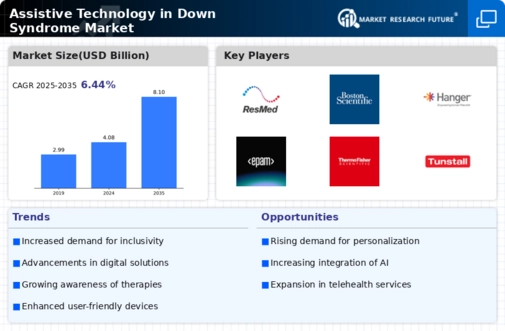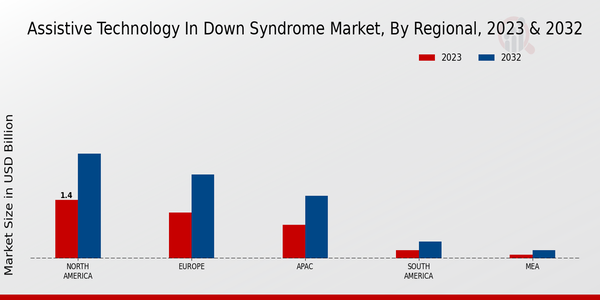Market Growth Projections
Focus on Inclusive Education
The emphasis on inclusive education practices is a crucial driver for the Global Assistive Technology in Down Syndrome Market Industry. Educational institutions are increasingly adopting inclusive policies that aim to integrate students with Down Syndrome into mainstream classrooms. This shift necessitates the use of assistive technologies that facilitate learning and communication for these students. Tools such as speech-to-text software and interactive learning applications are becoming essential in supporting the educational needs of individuals with Down Syndrome. As schools and educators recognize the importance of inclusivity, the demand for these technologies is likely to grow, further propelling the market forward.
Government Initiatives and Funding
Government initiatives aimed at supporting individuals with disabilities, including Down Syndrome, play a pivotal role in driving the Global Assistive Technology in Down Syndrome Market Industry. Various countries are implementing policies that promote accessibility and inclusion, thereby increasing funding for assistive technologies. For example, government grants and subsidies can help families acquire necessary devices and services, reducing financial barriers. Such initiatives not only enhance the availability of assistive technologies but also encourage research and development in this field. This supportive environment is likely to contribute to a compound annual growth rate of 6.43% from 2025 to 2035, reflecting a sustained commitment to improving the lives of individuals with Down Syndrome.
Rising Prevalence of Down Syndrome
The increasing prevalence of Down Syndrome globally is a significant factor influencing the Global Assistive Technology in Down Syndrome Market Industry. As more individuals are diagnosed with Down Syndrome, the demand for specialized assistive technologies is expected to rise correspondingly. This trend is particularly evident in regions where healthcare access and prenatal screening have improved, leading to higher detection rates. The growing population of individuals with Down Syndrome necessitates a diverse range of assistive devices and services, from communication aids to educational tools. This expanding market is indicative of a broader societal recognition of the needs of individuals with Down Syndrome and their families.
Increasing Awareness of Down Syndrome
The growing awareness of Down Syndrome and its associated challenges is a primary driver for the Global Assistive Technology in Down Syndrome Market Industry. As educational institutions and healthcare providers enhance their understanding of Down Syndrome, there is a corresponding rise in the demand for assistive technologies tailored to meet the unique needs of individuals with this condition. This awareness is crucial in promoting early intervention strategies, which can significantly improve developmental outcomes. Consequently, the market is projected to reach 4.08 USD Billion in 2024, reflecting a robust commitment to supporting individuals with Down Syndrome through innovative technological solutions.
Technological Advancements in Assistive Devices
Rapid advancements in technology are transforming the landscape of the Global Assistive Technology in Down Syndrome Market Industry. Innovations in communication devices, educational software, and mobility aids are enhancing the quality of life for individuals with Down Syndrome. For instance, the integration of artificial intelligence and machine learning in educational tools allows for personalized learning experiences, catering to the specific needs of each user. These technological improvements not only facilitate better communication and learning but also promote independence among individuals with Down Syndrome. As a result, the market is expected to grow significantly, with projections indicating a value of 8.1 USD Billion by 2035.










